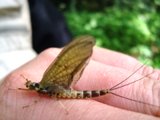Dry fly fishing
Fishing a dry fly is widely regarded as one of the oldest forms of catching rising trout and remains one of the most enjoyable for many river fly fishers. If you are looking for some great dry fly fishing video tips and the principles of dry fly fishing in rivers then press here. If you would like to know why dry flies work and the many ways that trout might take them then click here. For what's the best dry fly set up for river fishing visit this page.
Dry fly fishing in rivers is a huge topic over centuries old with enough pages written about it to fill a library. First we will briefly consider the basics.
What is a dry fly?
A dry fly is simply one that floats on the surface of the water. Trout feed on floating natural insects which either fall on the water by mistake and are usually based on land. Fly fishers and entomologists (insect fanatics) refer to these as terrestrials (e.g. ants, beetles, grasshoppers). Or they feed on surface flies that traveled from the river bed and emerged or hatched at the surface as a winged adult.
This metamorphosis is of great interest to experienced fly fisherman who will select a fly that copies
in size shape and colour of the emerging or adult insect. This is known as "matching the hatch". A good hatch of natural insects can act to send trout into a surface feeding frenzy. Trout feeding at the surface are observed by riseforms which look as if somebody has thrown a handful of pebbles in the river. These rising trout tend to get dry fly fisherman very excited because it often leads to a lot of rod bending action. The main insects that hatch in rivers are mayflies (the iconic fly fishers fly), caddis or sedge flies, stoneflies or midge.
 |
 |
A Mayfly with an artificial that copies it.
The basics of dry fly fishing are easy to grasp but the principles of stream dry fly fishing are a little more complex.